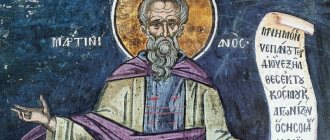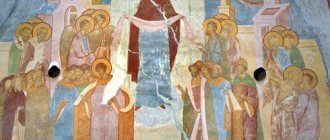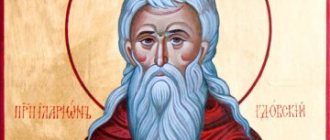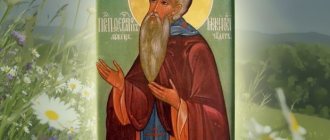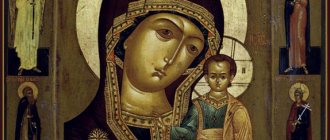On November 8, 4 Orthodox church holidays are celebrated. The list of events informs about church holidays, fasts, and days of honoring the memory of saints. The list will help you find out the date of a significant religious event for Orthodox Christians.
Church Orthodox holidays November 8
| Demetrius Day of the Great Martyr Demetrius of Thessalonica | Memorial Day of St. Demetrius, originally from Thessaloniki (Greece). After the death of his father, he was appointed proconsul by Emperor Maximian Galerius, ruler of the Thessalonian region. He was imprisoned by order of the emperor for disobedience (eradicating pagan customs instead of exterminating Christians) and killed with a spear in 306. |
| Martyr Luppus | Dedicated to Saint Lupus, a disciple of Demetrius of Thessalonica. He voluntarily surrendered into the hands of the Christian persecutors and was beheaded by the sword by order of Emperor Maximian Galerius. |
| Recollection of the great and terrible shaking (earthquake) that took place in Constantinople | The church commemorates the powerful earthquake in Constantinople in 740, during the reign of the iconoclastic emperor Leo III the Isaurian. |
| Venerable Theophilus of Pechersk, Archbishop of Novgorod | The church honors the memory of Novgorod Archbishop Theophilus. Died from a serious illness. The remains of the saint rest in the Far (Feodosiev) caves. |
On November 8, 4 Orthodox church holidays are celebrated. The list of events informs about church holidays, fasts, and days of honoring the memory of saints. The list will help you find out the date of a significant religious event for Orthodox Christians.
Signs for November 8th Day of Dmitry Solunsky:
- The deceased are leading Dmitriev's day to Rus'; They lead the dead, they watch over the living.
- If the ancestors rest during Grandfather's Week (there is a thaw), then the entire winter will be humid.
- Dmitrov's Saturday was always celebrated solemnly: they walked to the graves of their own dead and served memorial services there, and organized rich treats - funeral feasts. It was also believed that the more generous the offerings for the priests and clergy who celebrate requiem services, and the more plentiful their refreshments, the more accurately peace and joy will be delivered to the afterlife soul in the next world.
- On Dmitriev's day, a sparrow brews beer under a bush.
- Dmitriev's day - winter is already creeping up on the fence.
- It doesn't become winter until Dmitrov Saturday.
- If November 8 is cold and snowy, spring is late and cool, and if there is a thaw, winter and spring are warm.
- If Dmitriev's day is in the snow, then Holy (Easter) is in the snow, and Dmitriev is in the snow, and Holy is in the snow. On Mithria the rivers freeze (Siberia).
- The girls are cunning - they are going to marry Dmitry, because after that days there are rarely marriages in the villages before the winter meat-eater.
Dmitriev day
Great Martyr Demetrius of Thessalonica.
Memorial Day of St. Demetrius, originally from Thessaloniki (Greece). After the death of his father, he was appointed proconsul by Emperor Maximian Galerius, ruler of the Thessalonian region. He was imprisoned by order of the emperor for disobedience (eradicating pagan customs instead of exterminating Christians) and killed with a spear in 306.
The Holy Great Martyr Demetrius of Thessaloniki was the son of the Roman proconsul in Thessaloniki (modern Thessaloniki, Slavic name - Thessaloniki). It was the third century of Christianity. Roman paganism, spiritually broken and defeated by a host of martyrs and confessors of the Crucified Savior, intensified persecution. The father and mother of Saint Demetrius were secret Christians. In a secret house church that was in the house of the proconsul, the boy was baptized and instructed in the Christian faith. When his father died, and Demetrius had already reached adulthood, Emperor Galerius Maximian, who ascended the throne in 305, summoned him and, convinced of his education and military-administrative abilities, appointed him in his father’s place as proconsul of the Thessalonian region.
The main task entrusted to the young strategist was to defend the city from barbarians and exterminate Christianity. It is interesting that among the barbarians who threatened the Romans, our ancestors, the Slavs, occupied an important place, especially willingly settling on the Thessalonian Peninsula. There is an opinion that Dimitri's parents were of Slavic origin. In relation to Christians, the will of the emperor was expressed unambiguously: “Put to death everyone who calls on the name of the Crucified One.” The emperor did not suspect, when appointing Demetrius, what a wide path of confessional exploits he was providing for the secret ascetic.
Having accepted the appointment, Demetrius returned to Thessalonica and immediately confessed and glorified our Lord Jesus Christ before everyone. Instead of persecuting and executing Christians, he began to openly teach the inhabitants of the city the Christian faith and eradicate pagan customs and idolatry. The compiler of the Life, Metaphrastus, says that he became for Thessalonica in his teaching zeal “the second Apostle Paul,” because it was the “apostle of tongues” who once founded the first community of believers in this city (1 Thess., 2 Thess.). Saint Demetrius was destined by the Lord to follow the holy Apostle Paul in martyrdom.
When Maximian learned that the newly appointed proconsul was a Christian, and converted many Roman subjects, carried away by his example, to Christianity, the emperor’s anger knew no bounds. Returning from a campaign in the Black Sea region, the emperor decided to lead the army through Thessalonica, full of desire to deal with the Thessalonian Christians.
Having learned about this, Saint Demetrius ordered his faithful servant Lupp in advance to distribute the property to the poor with the words:
“Divide the earthly riches among them; let us seek for ourselves heavenly riches.”
And he devoted himself to fasting and prayer, preparing himself to accept the crown of martyrdom.
When the emperor entered the city, Demetrius was summoned to him, and he boldly confessed himself to be a Christian and exposed the untruth and vanity of Roman polytheism. Maximian ordered the confessor to be imprisoned, and an Angel came down to him in prison, comforting him and strengthening him in his feat. Meanwhile, the emperor indulged in gloomy gladiatorial spectacles, admiring how his favorite strongman, a German named Liy, threw the Christians he had defeated in the fight from the platform onto spears. A brave young man named Nestor from Thessaloniki Christians came to his mentor Demetrius in prison and asked to bless him for single combat with the barbarian. With the blessing of Demetrius, Nestor overpowered the ferocious German with the prayers of the holy saint and threw him off the platform onto the spears of the soldiers, just as a pagan killer threw off Christians. The angry ruler ordered the immediate execution of the holy martyr Nestor (October 27) and sent guards to the prison to pierce Saint Demetrius, who blessed him for his feat, with spears.
At dawn on October 26, 306, warriors appeared in the underground dungeon of the holy prisoner and pierced him with spears. The faithful servant Saint Luppus collected the blood of the holy Great Martyr Demetrius on a towel, removed the imperial ring from his finger, a sign of his high dignity, and also dipped it in the blood. With a ring and other shrines, consecrated with the blood of Saint Demetrius, Saint Luppus began to heal the sick. The emperor ordered to seize and kill him.
The body of the Holy Great Martyr Demetrius was thrown out to be devoured by wild animals, but the Thessalonica Christians took it and secretly buried it. Under Saint Constantine, Equal to the Apostles (306-337), a church was erected over the tomb of Saint Demetrius. A hundred years later, during the construction of a new majestic church on the site of the old one, the incorruptible relics of the holy martyr were discovered. Since the 7th century, during the cancer of the Great Martyr Demetrius, a miraculous outflow of fragrant myrrh begins, in connection with which the Great Martyr Demetrius receives the church name Myrrh-Streaming.
Several times, admirers of the Thessalonica wonderworker made attempts to transfer his holy relics or particles of them to Constantinople. But invariably Saint Demetrius mysteriously manifested his will to remain the patron and protector of his family in Thessalonica. Repeatedly approaching the city, the pagan Slavs were driven away from the walls of Thessalonica by the sight of a formidable, bright young man who walked around the walls and inspired terror in the soldiers. Perhaps this is why the name of Saint Demetrius of Thessalonica is especially revered among the Slavic peoples after their enlightenment with the light of the Gospel truth. On the other hand, the Greeks considered Saint Demetrius to be a Slavic saint par excellence.
The name of the Holy Great Martyr Demetrius of Thessalonica is associated, by God’s decree, with the very first pages of the Russian chronicle. When the Prophetic Oleg defeated the Greeks near Constantinople (907), as the chronicle reports, “the Greeks were afraid and said: it is not Oleg, but Saint Demetrius sent against us from God.” Russian soldiers always believed that they were under the special protection of the Holy Great Martyr Demetrius. Moreover, in ancient Russian epics, the Great Martyr Demetrius is portrayed as Russian by origin - this is how this image merged with the soul of the Russian people.
Church veneration of the Holy Great Martyr Demetrius in the Russian Church began immediately after the Baptism of Rus'. The foundation of the Dimitrievsky Monastery in Kyiv, later known as the Mikhailov-Golden-Domed Monastery, dates back to the early 70s of the 11th century. The monastery was built by the son of Yaroslav the Wise, Grand Duke Izyaslav, in Baptism by Demetrius († 1078). The mosaic icon of St. Demetrius of Thessalonica from the Cathedral of the Dimitrievsky Monastery has survived to this day and is located in the State Tretyakov Gallery. In 1194-1197, the Grand Duke of Vladimir Vsevolod III the Big Nest, in the baptism of Demetrius, “created a beautiful church in his courtyard, the holy martyr Demetrius, and decorated it wonderfully with icons and writings” (i.e., frescoes). Dimitrievsky Cathedral is still a decoration of ancient Vladimir.
The miraculous icon of St. Demetrius of Thessaloniki from the iconostasis of the cathedral is also now located in Moscow in the Tretyakov Gallery. It is written on a board from the tomb of the Holy Great Martyr Demetrius, brought in 1197 from Thessaloniki to Vladimir. One of the most valuable images of the saint is the fresco on the pillar of the Vladimir Assumption Cathedral, painted by the reverend monk-icon painter Andrei Rublev. The veneration of Saint Demetrius continued in the family of Saint Alexander Nevsky (November 23). Saint Alexander named his eldest son in honor of the holy great martyr. And the youngest son, the holy noble prince Daniel of Moscow († 1303; commemorated March 4), erected a temple in Moscow in the name of the holy great martyr Demetrius in the 1280s, which was the first stone church in the Moscow Kremlin. Later, in 1326, under Prince John Kalita, it was dismantled, and the Assumption Cathedral was erected in its place.
Since ancient times, the memory of Saint Demetrius of Thessalonica has been associated in Rus' with military feats, patriotism and defense of the Fatherland. The saint is depicted on icons as a warrior in feathered armor, with a spear and sword in his hands. On the scroll (in later images) they wrote a prayer with which Saint Demetrius turned to God for the salvation of his native Thessaloniki:
“Lord, do not destroy the city and the people. If you save the city and the people, I will be saved with them; if you destroy them, I will die with them.”
In the spiritual experience of the Russian Church, the veneration of the Holy Great Martyr Demetrius of Thessalonica is closely connected with the memory of the defender of the Motherland and the Church, the Grand Duke of Moscow Demetrius of Donskoy († 1389). “The Sermon on the Life and Repose of Grand Duke Dimitri Ivanovich, Tsar of Russia,” written in 1393, like other ancient sources, praises him as a saint. Spiritual son and pupil of Metropolitan Alexy, Saint of Moscow († 1378; commemorated February 12), student and interlocutor of the great prayer books of the Russian land - St. Sergius of Radonezh († 1392; commemorated September 25), Demetrius of Prilutsk († 1392; commemorated February 11), St. Theodore of Rostov († 1394; commemorated November 28), Grand Duke Demetrius “was very sad about the churches of God, and held the country of the Russian land with his courage: he defeated many enemies who came against us and fenced his glorious city Moscow with wonderful walls.”
Since the time of the white-stone Kremlin built by Grand Duke Dimitri (1366), Moscow began to be called White-stone.
“The Russian land flourished during the years of his reign,” the title “Word” testifies.
Through the prayers of his Heavenly patron, the holy warrior Demetrius of Thessaloniki, Grand Duke Demetrius won a series of brilliant military victories that predetermined the further rise of Russia: he repelled the onslaught of the Lithuanian troops of Olgerd on Moscow (1368,1373), defeated the Tatar army of Begich on the Vozha River (1378), crushed military power of the entire Golden Horde in the battle on the Kulikovo field (September 8, 1380 on the day of the celebration of the Nativity of the Blessed Virgin Mary) between the Don and Nepryadva rivers.
The Battle of Kulikovo, for which the people named Dimitri Donskoy, became the first all-Russian national feat that rallied the spiritual forces of the Russian people around Moscow. “Zadonshchina,” an inspired heroic poem written by priest Zephaniah Ryazan (1381), is dedicated to this turning point in Russian history.
Prince Dimitry Donskoy was a great admirer of the Holy Great Martyr Demetrius. In 1380, on the eve of the Battle of Kulikovo, he solemnly transferred from Vladimir to Moscow the main shrine of the Vladimir Demetrius Cathedral - the icon of the Great Martyr Demetrius of Thessalonica, written on the board of the saint’s tomb. In the Moscow Assumption Cathedral, a chapel was built in the name of the Great Martyr Demetrius. In memory of the soldiers who fell in the Battle of Kulikovo, Dimitrievskaya Parental Saturday was established for church-wide commemoration.
For the first time, this requiem service was performed at the Trinity-Sergius Monastery on October 20, 1380 by St. Sergius, Abbot of Radonezh, in the presence of the Grand Duke Demetrius Donskoy himself. Since then, it has been celebrated annually in the monastery with the solemn commemoration of the heroes of the Battle of Kulikovo, including the schema-monks-warriors Alexander (Peresvet) and Andrei (Oslyabi).
Prayers to St. Macarius
“O sacred head, reverend father, most blessed Abvo Macarius! Do not completely forget your poor, but remember us in your holy and auspicious prayers to God. Remember your flock, which you yourself shepherded, and do not forget to visit your children. Pray for us, Holy Father, for your spiritual children, as if you have boldness towards the Heavenly King. Do not remain silent for us to the Lord, and do not despise us, who honor you with faith and love. Remember us, unworthy, at the Throne of the Almighty, and do not stop praying for us to Christ God: for grace has been given to you to pray for us. We do not imagine that you are dead: even though you passed away from us in body, you remain alive even after death. Do not give up on us in spirit, keeping us from the arrows of the enemy, and all the charms of the devil, and the snares of the devil, our good shepherd. Even though your relics are always visible before our eyes, your holy soul with the angelic hosts, with disembodied faces, with the Heavenly Powers standing at the Almighty Throne, rejoices with dignity. Knowing that you are truly alive even after death, we bow down to you and we pray to you: pray for us to the Almighty God for the benefit of our souls and to ask for time for repentance, and for the unrestrained transition from earth to Heaven, bitter ordeals, demons, princes of the air and eternal to be freed from torment, and to be an heir to the Kingdom of Heaven with all the righteous who have pleased our Lord Jesus Christ from time immemorial: to Him belongs all glory, honor and worship, together with His Beginning Father, and His Most Holy and Good and Life-Giving Spirit, now and ever, and unto ages of ages. . Amen".
Mon, 07 Jun 2021 11:33:25 +0300
© Author: Ershova Svetlana
Martyr Luppus
Dedicated to Saint Lupus, a disciple of Demetrius of Thessalonica. He voluntarily surrendered into the hands of the Christian persecutors and was beheaded by the sword by order of Emperor Maximian Galerius.
Saint Lupus (Lupp) lived at the turn of the 3rd–4th centuries. He was a slave of Saint Demetrius of Thessalonica. Lupus was present at the martyrdom of the master in Thessalonica and took his bloody tunic and the imperial ring, stained with the martyr's blood. Subsequently, he performed many miracles and healings with the power of these shrines, and thereby strengthened the faith of Christians.
That is why the emperor, still in Thessalonica, ordered his arrest and torture. Saint Lupus was condemned to death. According to legend, during his execution, two warriors who were assigned to carry out this task turned their swords against each other and wounded each other. The martyr prayed to Christ that He would grant him the grace of baptism before death. At that moment, a cloud stopped above him, from which water poured out. Having put on the new man and the power of the Holy Spirit, Lupus steadfastly endured the torment, after which he was beheaded. By this he freed himself from the slavery of earthly life in order to be worthy of the Kingdom of Heaven.
The Synaxarion mentions this saint without providing any information about his life. Slavic sources identify him with the servant of St. Demetrius (October 26). This assumption is confirmed in the couplet of Christopher of Mytilene (11th century):
“Saint Lupus was a slave, but through beheading by the sword he approached God as a free man and friend.” In the 7th century St. Lupus was especially revered in Nova, in Lower Moesia (near Svishtov): “Having heard that the general (Peter, brother of the Emperor of Mauritius - Ed.) was coming to them, the local residents left the city and, having given him a remarkably magnificent reception, begged Peter to take part with them in the celebration in honor of the martyr Lupus; on this day they had the eve of the feast of the martyr Lupus with a night vigil” (Theophylact Simocatta. History. VII. II, 17).
Events of November 8 in Ukraine and the world
- 1519 - Hernan Cortes, a Spanish conquistador arrived in Tenochtitlan (Mexico City).
- 1699 - Peter I issues the first decree on the recruitment of recruits. On this day, the creation of a regular Russian army began.
- 1793 - a museum opened in the French Louvre.
- 1903 - The electrocardiograph is invented in the Netherlands.
- 1917 - victory of the Bolshevik revolution in Russia, the Bolsheviks captured the Winter Palace in Petrograd.
- 1923 - The Nazis from the NSDAP attempted to seize government power in Germany, an event known as the Beer Hall Putsch.
- 1961 - the first KVN program was released in the USSR.
- 1994 - George W. Bush was elected governor of Texas, USA.
- 1999 - Georgia received its first visit from the Pope (John Paul II).
Subscribe to the daily email newsletter from the creators of the number 1 newspaper in Ukraine. Every evening in your inbox the most important, exclusive and useful. Subscribe
Recollection of the great and terrible shaking (earthquake) that happened in Constantinople
The church commemorates the powerful earthquake in Constantinople in 740, during the reign of the iconoclastic emperor Leo III the Isaurian.
On November 8, the Orthodox Church celebrates an event that is directly related to Constantinople. The fact is that in the middle of 740 there was a terrible earthquake there, which affected other small towns of the Byzantine Empire.
ANNUAL SERVICE IN HONOR OF THE TRAGIC EVENT Constantinople was at the epicenter of the disaster, and therefore the tower of the Feodosian Wall collapsed there, residential buildings and other buildings were razed to the ground. The clergy characterize this natural disaster as the end of the reign of Leo the Third Isaurian. It is worth noting that the king was very cruel towards Christians, and repeatedly carried out persecutions in order to exterminate as many believers as possible. Leo the Isaurian was dethroned, and three months later he was found dead at home. In memory of the tragic incident, the clergy compiled a troparion, as well as a kontakion. An annual veneration with a prayer service in all Orthodox churches was also approved.
WORDS OF HIEROMONK JOB, IN MEMORY OF THE EARTHQUAKE The pious Hieromonk Job (Gumerov) repeatedly said that on this day close attention should be paid not only to the memory of St. Demetrius of Thessalonica (the saint is also venerated on November 8), but also to all the affected Christians who became victims of the terrible earthquake . He also argued that all the miraculous events that took place during that period should be conveyed to future generations so that in modern times we would realize the power of the Lord God. From the words of Saint Job:
“An earthquake is considered a purely natural phenomenon, but since biblical times this event has been a symbol of the power and strength of the Lord God. This is a symbol of the Court of the Lord. After all, earthquakes very often occurred during state changes or upheavals; one of such moments was the earthquake during the reign of King Leo the Isaurian, marking the end of his reign.”
A MIRACULOUS EVENT IN TSARGRAD (740) During a strong and terrible earthquake that struck not only Constantinople, but also other villages, people began to pray to the Lord God with requests for an end to this disaster, because it occurred approximately once or twice a day. One day, the clergy organized a general prayer, and people came out to the central square of the city to repent for their sins and ask the Creator for salvation. When the service began, one young man unexpectedly flew into the sky, and after a few minutes descended back to the ground. It is worth noting that he was completely unharmed and told a lot of interesting things. The young man said:
“When I ascended into heaven, I heard the words of prayer chanted by the Angels.”
After that, he told the words of the prayer, and people began to diligently say it, believing in the words of the young man. Just a few minutes later, people suddenly felt great relief inside, and after that the earthquakes did not occur again.
What can you do today June 8
You can and should:
1. Go to church for a service, light candles for the health and peace of your loved ones.
2. Ask for forgiveness from those who were offended.
3. Rejoice and have fun - there should be no place for despondency and sadness on such a bright day.
Don’t forget to pray to Saint Macarius and ask the elder for protection from evil people, the granting of wisdom and meekness, strengthening of faith and help in difficult life situations. The monk answers all sincere prayers and always helps those who have good and honest intentions.
Venerable Theophilus of Pechersk, Archbishop of Novgorod
The church honors the memory of Novgorod Archbishop Theophilus. Died from a serious illness. The remains of the saint rest in the Far (Feodosiev) caves.
The last Novgorod saint elected at a people's meeting. His time as a pastor was very difficult. Posadnitsa Martha Boretskaya and her followers outraged the people against the Grand Duke of Moscow John III and incited hatred of St. Theophilus in the flock. Some of the Novgorodians were inclined to go over to the side of Lithuania, betraying the Moscow prince, and were ready to commit apostasy. Saint Theophilus stopped the rebellious Novgorodians and urged them not to betray Orthodoxy. Through his intercession, he freed many boyars from Lithuanian prisons.
In 1480, Saint Theophilus was sent for imprisonment to the Moscow Miracle Monastery, where he became seriously ill. In a sleepy vision, Saint Niphon (+ 1156), buried in the caves of St. Anthony of Pechersk, appeared to him and reminded him of his promise to worship the Pechersk wonderworkers. The holy archbishop went to Kiev and was already approaching the Dnieper, when his illness intensified, and he received a revelation that although he would not reach the caves alive, his body would rest in them, which came true. His honest relics now rest in the Far (Feodosiev) caves.
Born on this day
- 1656 - Edmund Halley, English astronomer and mathematician.
- 1711 - Mikhail Vasilyevich Lomonosov, famous Russian natural scientist, chemist and physicist.
- 1847 - Bram Stoker, writer who wrote the first novel, Dracula.
- 1883 - Ostap Lutsky, Ukrainian social and political figure and poet.
- 1891 - Oles Dosvitny, Ukrainian dissident writer.
- 1900 - Margaret Mitchell, writer, author of the novel Gone with the Wind.
- 1922 - Christian Barnard, cardiologist, author of the first open heart surgery.
- 1935 - Alain Delon, famous French film actor, director and screenwriter, sex symbol of the 1960s.
- 1951 - Stas Namin (real name Anastas Mikoyan), Soviet composer, musician, producer.
- 1960 - Oleg Menshikov, Soviet theater and film actor, theater director, teacher.

